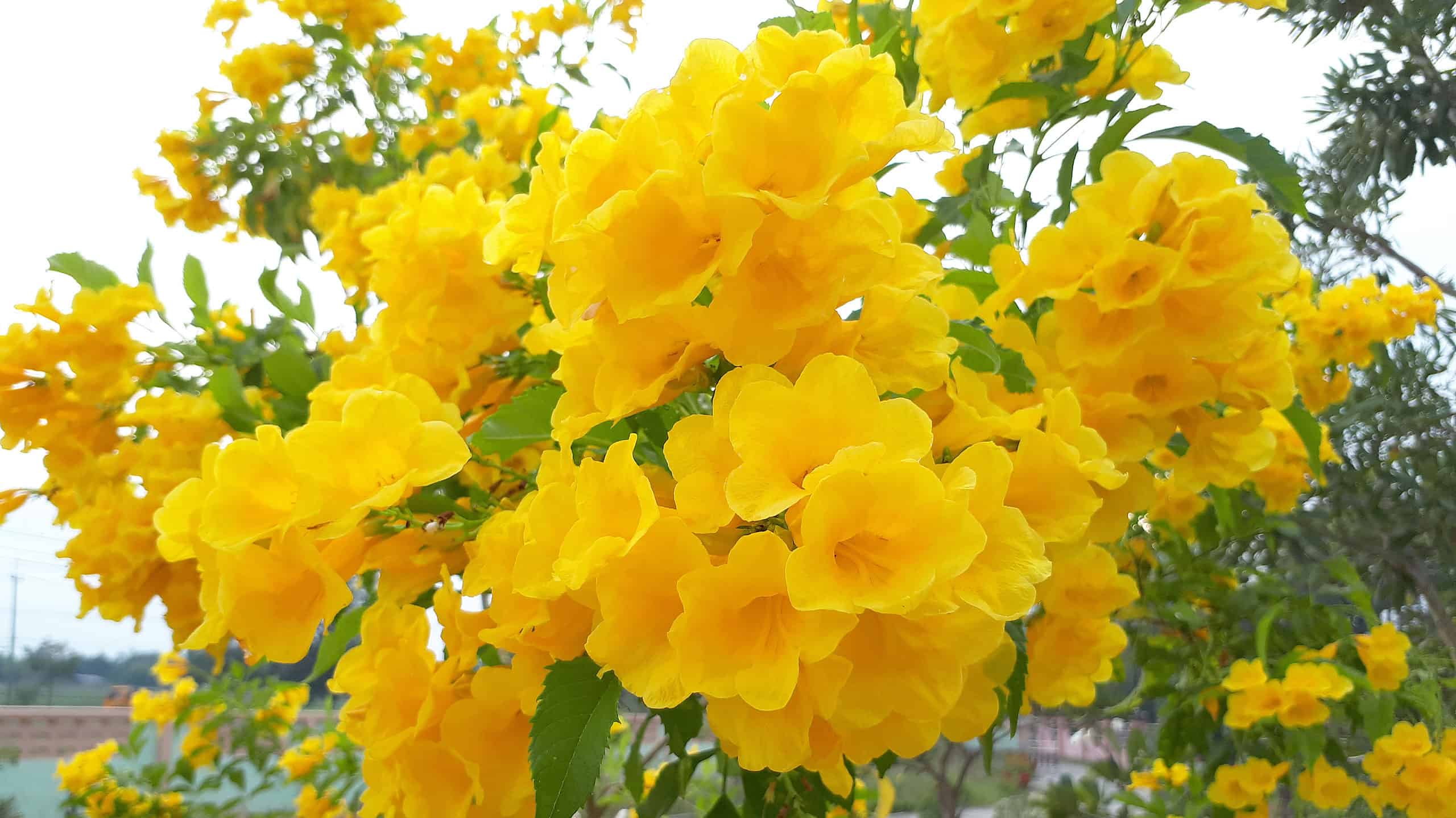It’s hard not to envision hot, dry, and dusty conditions when you think about Texas. On average, Texas receives only 0.1 inches of snow per year. That doesn’t mean beautiful gardens don’t exist within the Lone Star State! Shrubs can create a foundation for an outdoor space or be incorporated as the focal point in the garden. Creating beautiful outdoor spaces in Texas requires choosing the right kind of shrubs for your region. Consult the USDA Hardiness Zone Map if you aren’t sure which shrubs will survive in your area. Let’s examine some shrubs that will make your Texas garden stand out!
1. Cenizo (Leucophyllum frutescens)

In 2005, cenizo was designated the Official Native Shrub of Texas by the State Legislature.
©Muthita Panphloi/iStock via Getty Images
A native Texas evergreen, cenizo’s flowering pattern has led to this shrub being called the “barometer bush.” Once well-established, cenizo produces gorgeous purple blooms after it rains or in times of high humidity. Cenizo produces small seeds which can be collected after the flowers fade in late summer. Seeds should either be planted in a greenhouse or stored in a dry, cool place. Plant cenizo seeds in springtime, when the threat of frost has passed. It may take up to two years before cenizo becomes established enough to bloom. Mature cenizo shrubs are drought and heat tolerant. They prefer dry, well-drained soil and full sun. Cenizo requires little additional watering. Landscapers often incorporate cenizo into outdoor designs as privacy hedges. Cenizo can grow to heights of six feet.
2. Agarita (Mahonia trifoliolata)

Jellies and jams can be made from agarita berries.
©B Norris/Shutterstock.com
Also known as wild currant, agarita produces grey-hued, three-pointed leaves that resemble holly. Agarita, an evergreen, is perfect for a sprawling, cottage garden. In the early spring, agarita displays yellow flowers. When the blooms fade, they are replaced by edible red berries. The sharp points of the foliage, which remains on the plant year-round, prevent deer from consuming agarita. Plant agarita in the fall. Agarita can grow up to six feet tall and expand via suckering. For smaller outdoor spaces, restrict the plant’s growth by removing the suckers. Agarita loves dry, rocky, and limestone soil that is well-drained. That means the richer soil conditions around Houston are not suitable for growing agarita. Agarita prefers full sun but can endure some light shade.
3. Southern Wax Myrtle (Myrica cerifera)
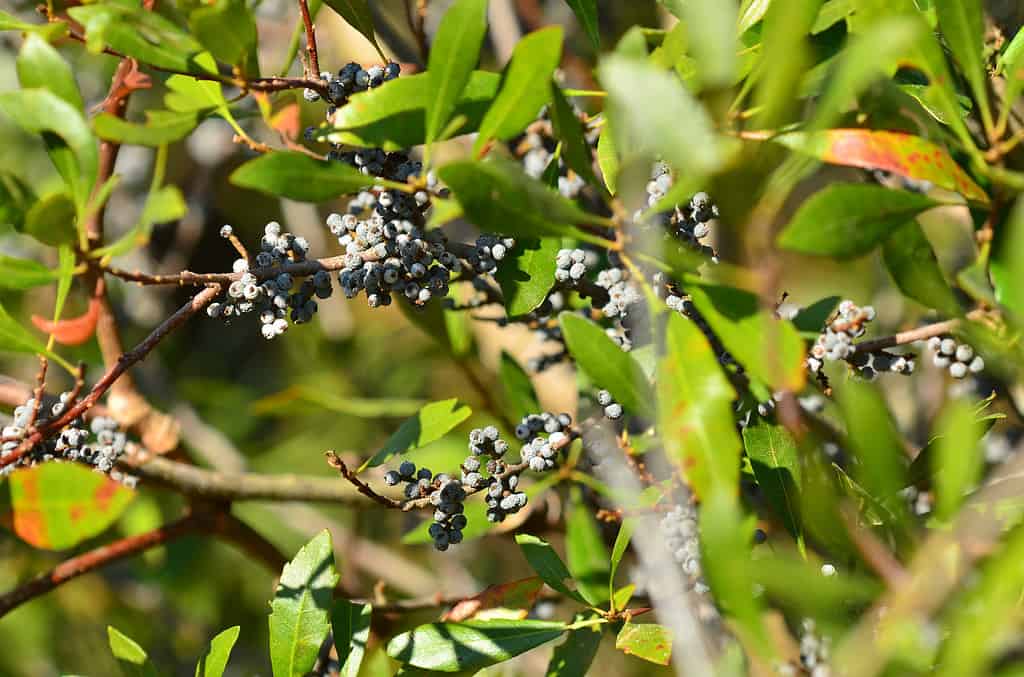
Wax from the drupes is used in the making of bayberry candles.
©cturtletrax/iStock via Getty Images
Native to east Texas, the Southern Wax Myrtle is often used in Texas gardens as a screen or hedge. In optimal conditions, it can grow to a height of 25 feet. Small flowers begin to appear in late winter or early spring. Southern Wax Myrtle is dioecious, meaning there are both male and female plants. In the fall and winter, female Southern Wax Myrtles produce drupes, berry-like fruit that birds like to eat. However, there must be a male Southern Wax Myrtle in the vicinity for cross-pollination to occur. Remove the waxy outer coating of seeds before sowing or cold stratifying. Sow Southern Wax Myrtle seeds in the fall. Cuttings can be taken in the summer. Southern Wax Myrtle requires full sun to partial shade and sandy or loamy soil. Keep the soil moist! Southern Wax Myrtles like wet growing conditions.
4. Texas Mountain Laurel (Sophora secundiflora)
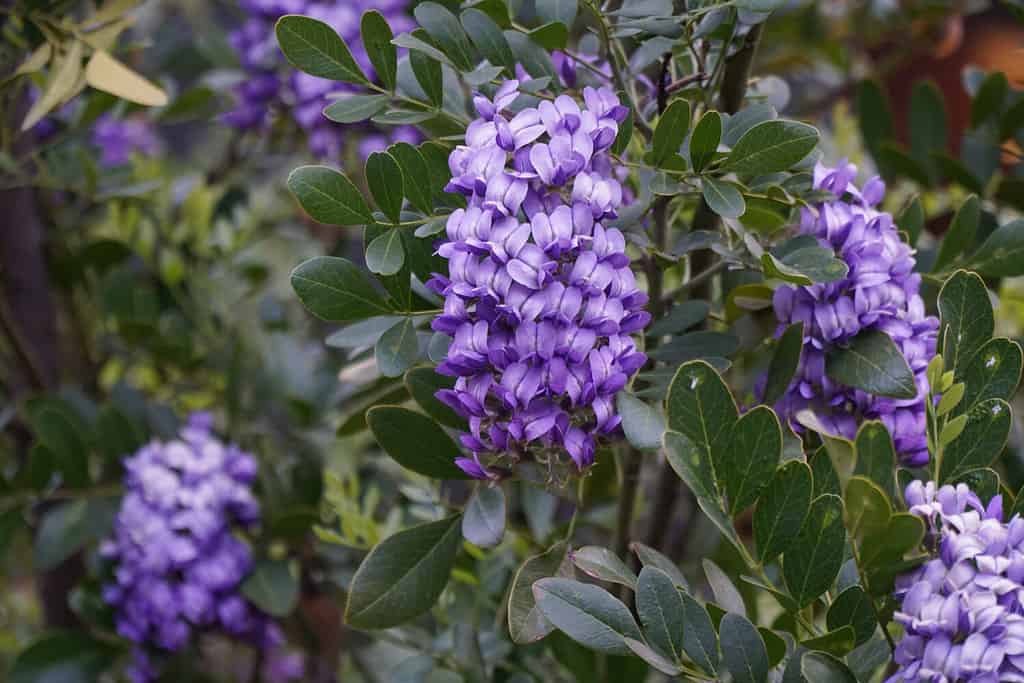
Cytosine, the toxic alkaloid in Texas Mountain Laurel seeds, is related to nicotine.
©Harry Thomas Flower/Shutterstock.com
Often planted as an ornamental evergreen, Texas Mountain Laurel brings year-round beauty to Texas gardens. Springtime brings the eruption of fragrant purple flower clusters that smell like grape candy. In the summer, the spent blooms are replaced by hairy seed pods. Those remain until fall, allowing dark green paddle-shaped leaves to remain through the winter. Texas Mountain Laurel often grows upright to a height between 10-15 feet. Seeds collected in summer before the hardening of the seed coat can be immediately sown for mass plantings. Older seeds should be scarified (breaking the seed coat with a sharp object) before planting in late fall or early winter. Plant Texas Mountain Laurel seeds where the plant will receive full to partial sun. Alkaline, dry, and well-drained soil is best for Texas Mountain Laurel. Although the flowers smell good, do not eat them. Both the blooms and seeds of the Texas Mountain Laurel are toxic.
5. Rock Rose (Pavonia lasiopetala)
As tough as it is pretty, rock rose serves as a filler plant or specimen shrub in Texas gardens. Native to the Trans-Pecos and Edwards Plateau in western Texas, rock roses present five-petaled pink flowers. It blooms from April to November, providing color well into the fall. Pollinators like bees and butterflies are attracted to rock roses. Rock roses get their name from their love of dry, rocky, limestone-rich soil. Once established, the rock rose has minimal water needs, but the soil should be well-drained. Plant rock roses in either full or partial sun. Rock rose is a perennial, but it self-seeds readily and has a tendency to sprawl. Consider placing rock rose in a cottage garden or somewhere it has room to expand. Self-propagation can be reduced by eliminating seedlings as soon as they pop up.
6. Glossy Abelia (Linnaea x grandiflora)
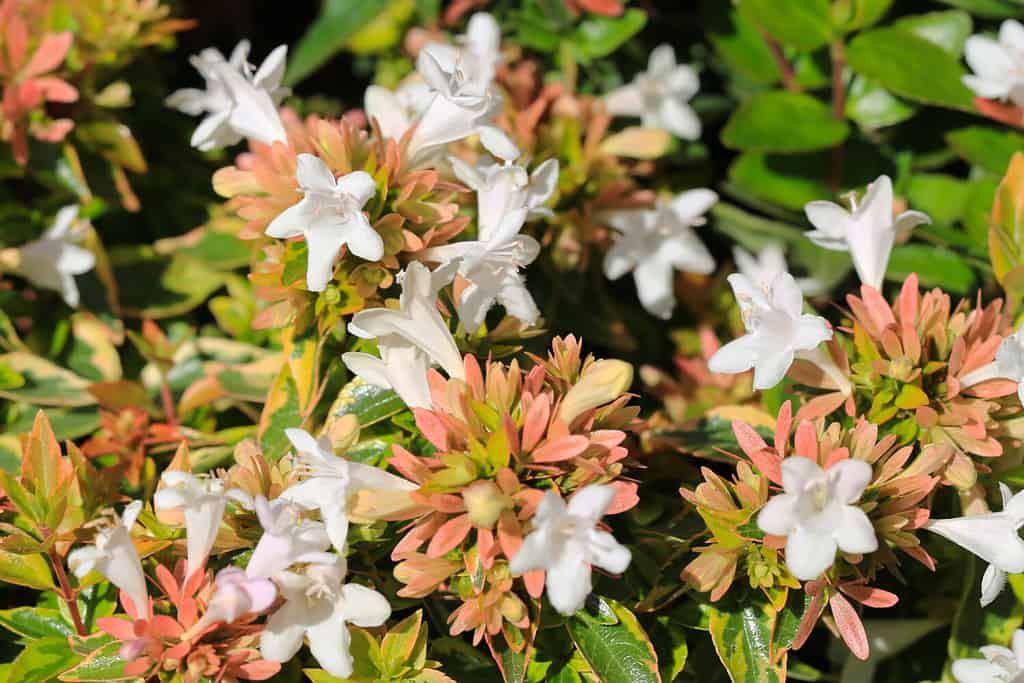
Glossy abelia is a member of the honeysuckle family (
Caprifoliaceae).
©Traveller70/Shutterstock.com
Requiring little maintenance, glossy abelia works perfectly in Texas gardens as a border plant. It grows between three to six feet wide and up to six feet tall. In the late spring, bloom clusters begin to appear which attract hummingbirds and bees. Its flowering season ends in fall when the leaves turn bronze. Although classified as an evergreen, some leaves may drop off during the winter. Glossy abelia isn’t finicky and does well in poor to average, well-drained soil. Flower and foliage production reaches its peak with full sun exposure, but glossy abelia can tolerate partially shaded areas. Prune glossy abelia if it starts getting leggy. Cultivars are available at nurseries. Glossy abelia can also be propagated from soft wood cuttings taken in the summer.
7. Littleleaf Boxwood (Buxus microphylla)

With some training and trimming, the littleleaf boxwood makes an excellent bonsai plant.
©spb2015/iStock via Getty Images
While the littleleaf boxwood may not have much ornamental value, it is perfect for hedging and creating focal lines throughout the garden. A dwarf variety, littleleaf boxwoods only reach heights of three feet. Littleleaf boxwoods grow slowly, exhibiting up to six inches of new growth per year. In late spring, littleleaf boxwood produces small, short-lived white flowers. The foliage consists of tightly-packed round leaves that remain on stems during winter. Littleleaf boxwoods grow well in partially shaded areas. Full sun may scorch the leaves. Littleleaf boxwoods also require protection from strong winds. Mulching around the plant helps retain soil moisture and regulate temperature. The roots of the littleleaf boxwood appreciate a moist and cool environment. Littleleaf boxwoods adapt to a variety of soil conditions as long as the soil is well-draining. Too much water could lead to root rot, which will kill the plant.
8. Yellow Bells (Tecoma stans)
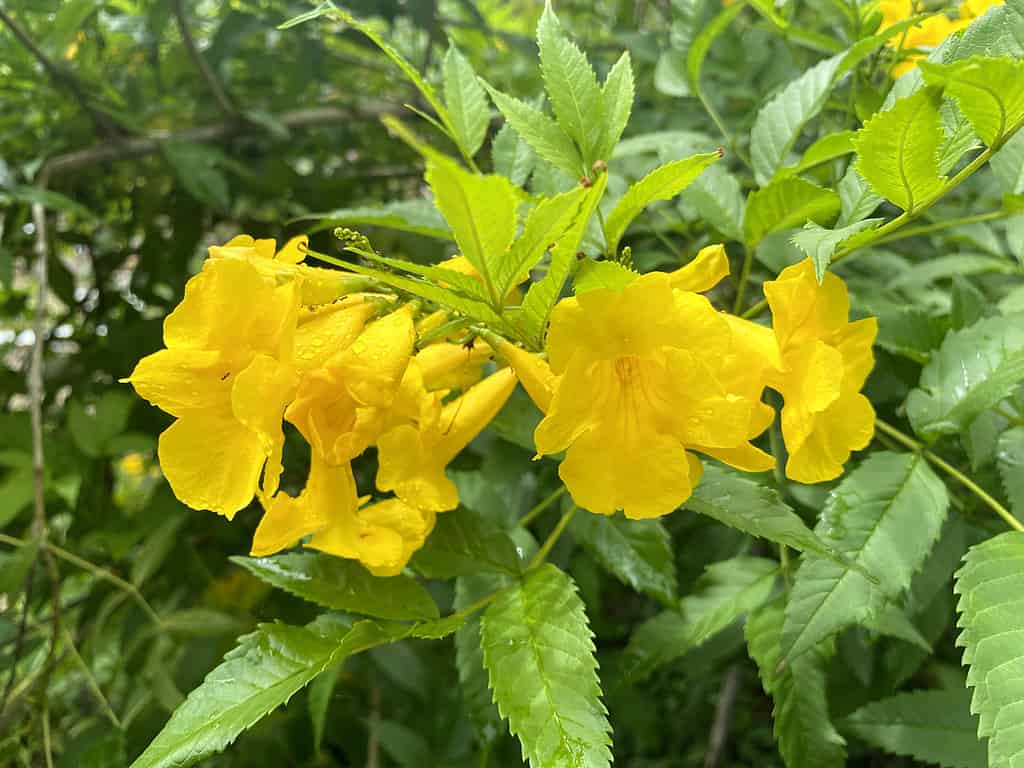
Practitioners of herbal medicine use the inner bark of yellow bells to treat kidney issues.
©mansum008/iStock via Getty Images
Often used as a border plant in gardens or along driveways, yellow bells provide a bright boost of color to the Texas landscape. In the spring, this plant displays yellow, trumpet-bell-shaped flowers. Those blooms last through fall, although yellow bells may bloom year-round in frost-free areas. In Central Texas, yellow bells exhibit deciduous behavior. Yellow bells are semi-evergreen in other parts of the state. Deadhead spent flowers to encourage more bloom production. Yellow bells can reach heights of 25 feet and widths of 20 feet. Trim the shrub to keep it at an appropriate size. When the flowers fade in the fall, eight-inch-long seed pods appear. In warmer areas of Texas, those seeds can be directly sown and will root easily. Yellow bells will also propagate from cuttings taken in the spring or summer. Full sun brings out the most flowers from yellow bells, but it can also tolerate partial shade. Plant yellow bells in rich, well-drained soil. Let yellow bells dry out between waterings. Tolerant of both drought and heat, yellow bells are well-suited to withstand the Texas climate!
9. Crepe Myrtle (Lagerstroemia indica)

In 1997, the Texas Legislature designated the crepe myrtle the Official State Shrub.
©LifeCollectionPhotography/Shutterstock.com
One of the most popular deciduous shrubs in Texas, the crepe myrtle is remarkably heat-tolerant. Even in the middle of a hot Texas summer, crepe myrtles continue putting out blooms. Crepe myrtles grow up to 20 feet high, making them a terrific focal point or ornamental shrub for outdoor spaces in Texas. A fast grower, crepe myrtles gain up to two feet of height per year. Blooms sometimes display in white, but more often in hues of purple, red, and pink. Plant crepe myrtles in late fall to early spring. Crepe myrtles prefer rich, well-drained soil. Full sun encourages the best flower production, but crepe myrtles can also be planted in partial shade.
10. Azalea (Rhododendron)

Nepal claims the azalea as its national flower.
©PatGallery/Shutterstock.com
Available in multiple sizes and bloom colors, azaleas are a wonderful addition to shady Texas gardens. Plant your azaleas in early spring where they won’t receive full afternoon sun. In Central Texas, plant azaleas in eastern or northern areas of the property. Because of the soil conditions in Texas, make amendments before planting azaleas. The soil should be acidic and rich in organic matter. This can be achieved by adding layers of peat moss, pine bark, and sulfur. Azaleas love moist soil but will suffer in soggy soil. Deep watering once a week during summer is sufficient. Mulch the planting area to ensure water retention and restrict the growth of weeds. Azaleas are beautiful, but keep your animals away! Azaleas contain toxins that upset the stomach.
11. Oakleaf Hydrangea (Hydrangea quercifolia)
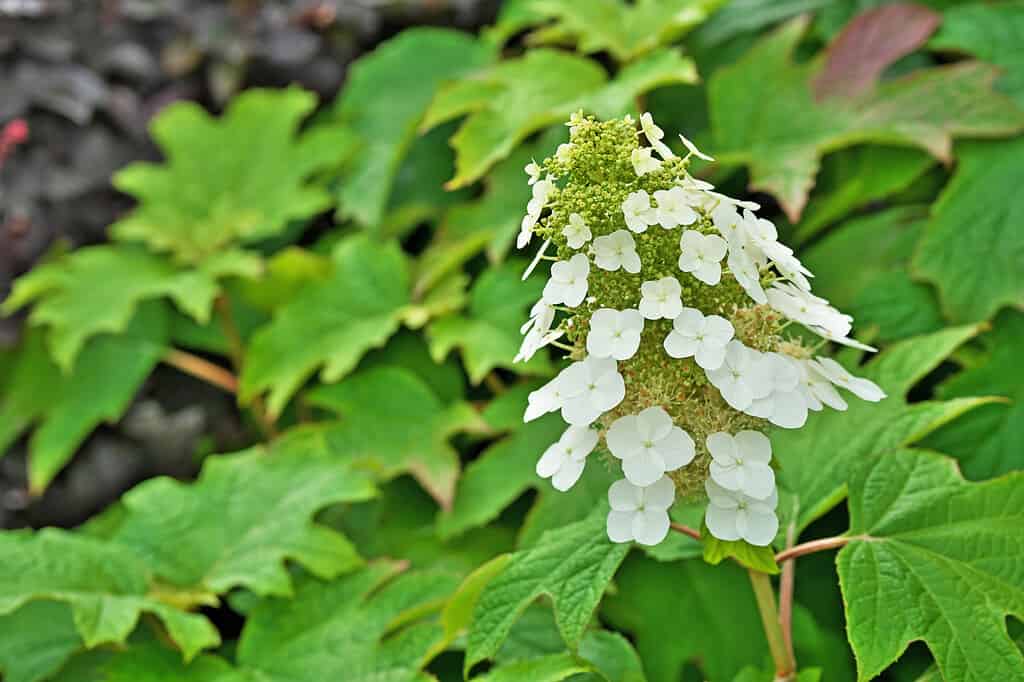
Although popular in Texas, oakleaf hydrangea is not native to the state.
©igaguri_1/iStock via Getty Images
Growing hydrangeas in Texas can be tricky because of the varying soil conditions throughout the state. Oakleaf hydrangeas are an excellent variety for Texas gardeners, but certain conditions need to exist for success. Pick a time when the weather is mild, such as early spring or late fall, to plant oakleaf hydrangeas. Choose a spot that receives dappled sunlight. While oakleaf hydrangeas enjoy the morning sun, they need shade during the heat of the day. Consider planting oakleaf hydrangeas on the northern side of a structure or under taller plants. Much of the soil in Texas, particularly in the Austin area, is alkaline. Hydrangeas perform best in soil that is mildly acidic. Amend the soil with compost, sulfur, or even coffee grounds. Consult your local county extension office for guidance. The soil should be rich and well-drained. Water mature oakleaf hydrangeas every two to three days during the heat of the summer. Once well-established, oakleaf hydrangeas begin producing white, cone-shaped blooms in late spring. Flowers should be pruned when they start to fade, usually sometime in July.
12. Elbowbush (Forestiera pubescens)
Featuring a dense growth pattern, elbowbush makes a great background shrub. Its twigs grow out from the branches at 90-degree angles, like a bent arm. Elbowbush is one of the first shrubs to display blooms in the spring. Male shrubs produce white flowers while female shrubs present yellow blooms. Both male and female elbowbushes, planted in proximity for proper cross-pollination, are needed to produce drupes on the female shrub. In optimal conditions, blackish-blue drupes begin appearing on female elbowbushes in June. Elbowbushes do well in both full sun and partial shade. These shrubs will thrive in a variety of soil conditions. Seeds require cold stratification. Planting seeds in the fall allows them to stratify underground. Visible growth will be noticeable in May.
13. Texas Lantana (Lantana urticoides)
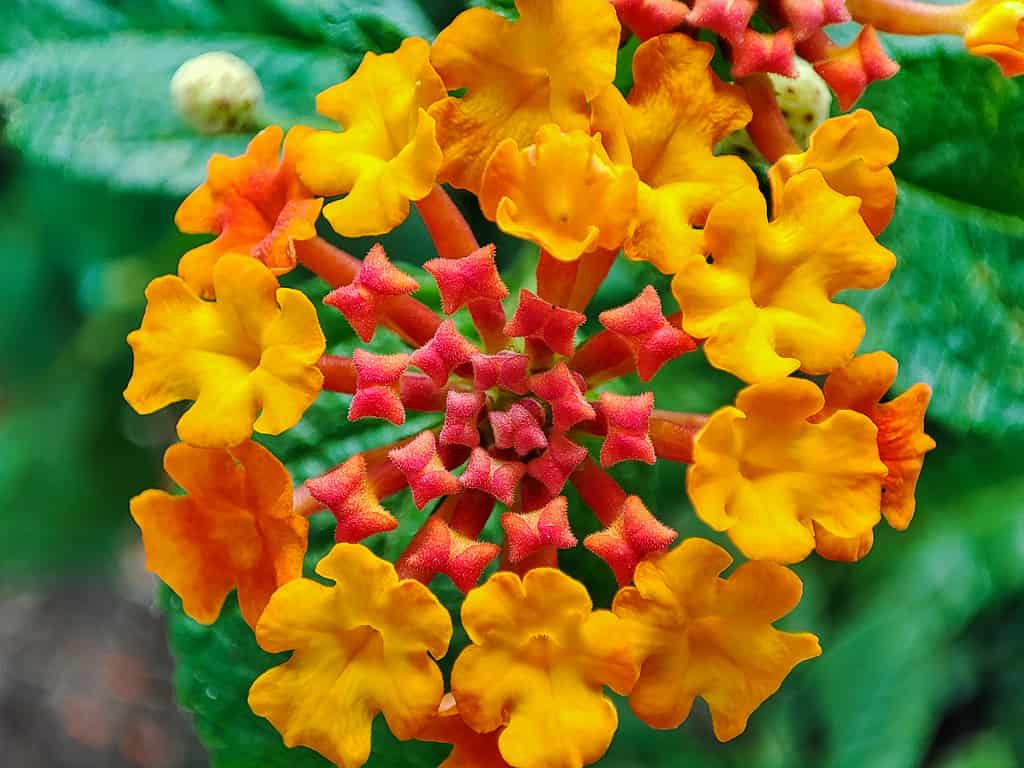
Rabbits and other wildlife avoid Texas lantana as a food source because the leaves smell bad.
©Syafrudin Akbar/iStock via Getty Images
Even in the full heat of summer, Texas lantana will provide continuous blooms. Texas lantana is often used as a ground cover, but it can also be found as a border plant or in cottage gardens. Blooms begin appearing in May, providing yellowish-orange flowers until November. After the flowers fade, black seed-bearing berries take their place. When the threat of spring frost has passed, plant Texas lantana in full sun or light shade. This shrub thrives in the heat. Drought-resistant, Texas lantana does well in well-drained poor, sandy, and rocky soil. It can take up to three years for Texas lantana to become well-established. Mature Texas lantana shrubs can grow to six feet tall and wide. The leaves will fall away during cold weather, making winter the best time to prune Texas lantana shrubs. Texas lantana is gorgeous, but it can be dangerous. Seeds are toxic to dogs, cats, horses, and humans. Skin irritation can develop after contact with foliage.
14. Flame Acanthus (Anisacanthus quadrifidus var. wrightii)
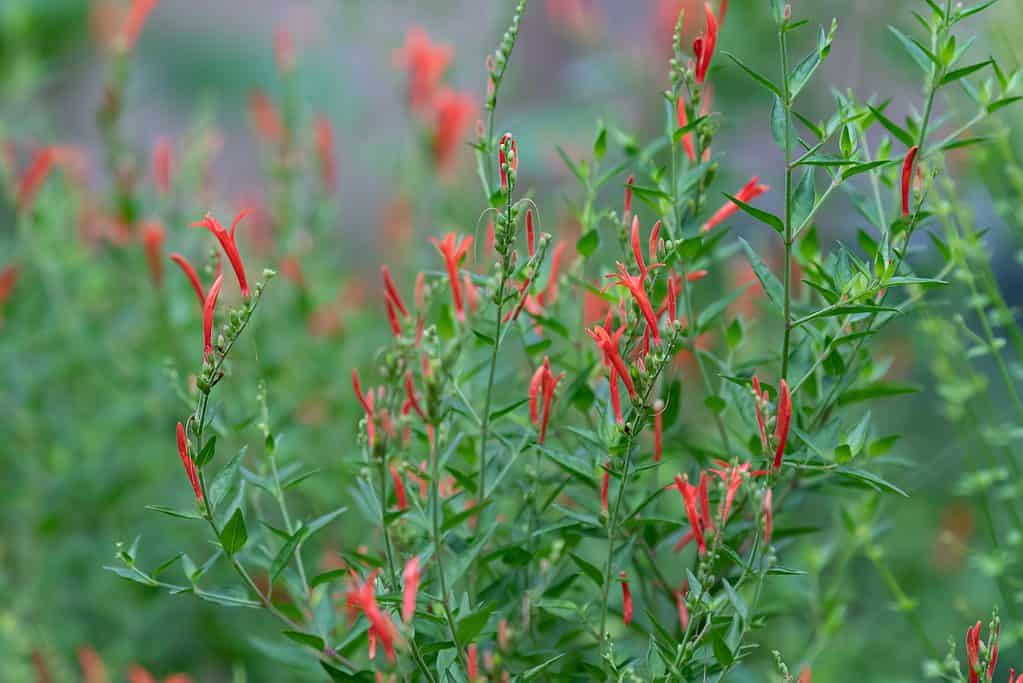
Texan Crescent butterflies (
Anthanassa texana) lay eggs on flame acanthus leaves.
©Marianne Pfeil/Shutterstock.com
Few shrubs will bring pollinators to the garden like flame acanthus. Birds, bees, and butterflies are attracted to the reddish-orange cylindrical flowers. Those blooms begin popping out in June before dying back in the fall. Flame acanthus is highly adaptable, thriving in the hot and rocky southern parts of Texas as well as the richer soil conditions of the Houston area. In the northern sections of Texas, such as Dallas, flame acanthus will die to the ground in the winter. However, in the spring, flame acanthus will revive and present new top growth. Plant flame acanthus in an area where the shrub will receive full sun to partial shade. Mature flame acanthus shrubs grow to between four and five feet tall. Well-established flame acanthus plants have minimal watering needs. Make sure the soil is well-drained. Flame acanthus self-seeds and will spread throughout a contained garden space. If desired, flame acanthus can be propagated from cuttings.
15. Rose of Sharon (Hibiscus syriacus)

Thomas Jefferson grew Rose of Sharon at all three of his homes.
©Heinsdorff Jularlak/Shutterstock.com
Hitting heights upwards of 10 feet, the Rose of Sharon is a stunning focal point for gardens in Texas. Mature Rose of Sharon shrubs display large flowers in varying shades of color from late spring until fall. Butterflies and hummingbirds love Rose of Sharon blooms. Rose of Sharon is easy to grow and requires little special maintenance. Exposure to full sun provides the most flowers, but Rose of Sharon also grows well in partial shade. Although Rose of Sharon prefers average soil, it will adapt to poor soil conditions. Soil should be well-drained while remaining moderately moist. Deep watering is recommended. Rose of Sharon self-seeds aggressively and is considered invasive in Kentucky, Tennessee, Pennsylvania, and Virginia. Tough to kill, Rose of Sharon is tolerant of heat, humidity, deer browse, drought, and air pollution.
16. Bridal Wreath Spirea (Spiraea prunifolia)
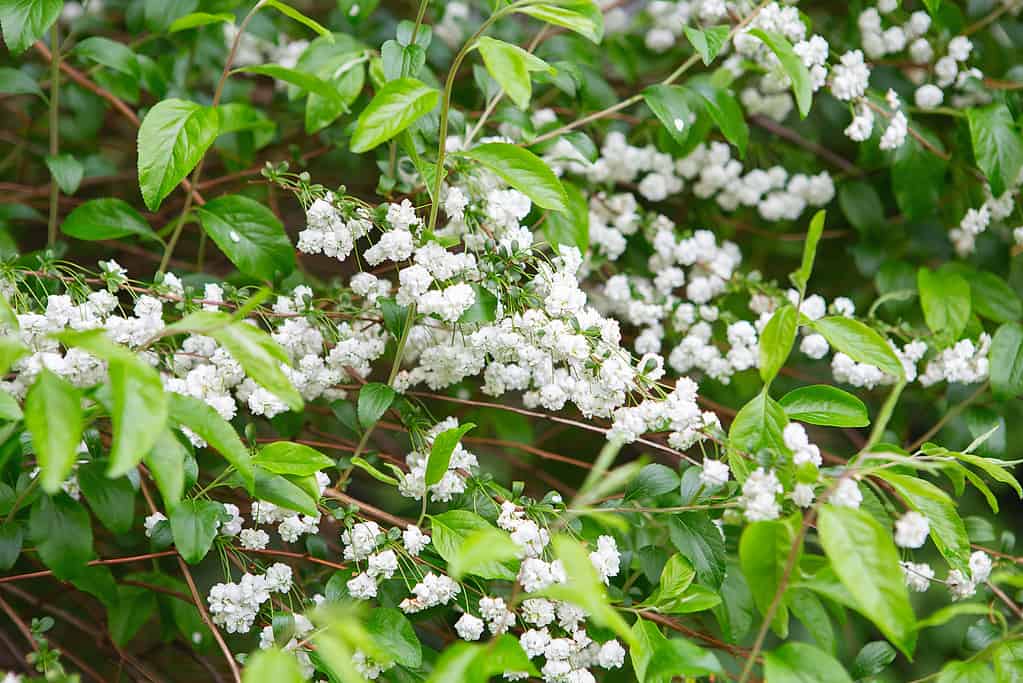
Spring brides often wear bridal wreath spirea in their hair during their weddings.
©nata_zhekova/iStock via Getty Images
With a short bloom time lasting only from March to May, bridal wreath spirea brightens Texas springs with shocks of white double flowers. Bridal wreath spirea has long stems that grow in an arching pattern. Flowers can appear before leaves begin to appear on the stems. After the flowers are gone, the dark green leaves remain until fall when they turn purple before dropping. Use bridal wreath spirea as focal points or outer borders in gardens. If not pruned back after the flowers fade, bridal wreath spirea can attain heights of nine feet. Planting time is spring or early fall. Cuttings will develop roots if placed in the ground during the fall. Give bridal wreath spirea full sun exposure for the best growth and flower production. Keep the roots moist after planting in average well-drained soil. Once well-established, bridal wreath spirea is drought-tolerant and resistant to air pollution.
Summary of the 16 Best Shrubs to Plant in Texas
| Plant Name | Soil Conditions | Light Requirements | Plant Type |
|---|---|---|---|
| Cenizo | Dry, well-drained | Full sun | Evergreen |
| Agarita | Dry, rocky, limestone | Full sun to light shade | Evergreen |
| Southern Wax Myrtle | Moist, sandy, loamy | Full sun to partial shade | Evergreen |
| Texas Mountain Laurel | Dry, alkaline, well-drained | Full to partial sun | Evergreen |
| Rock Rose | Dry, rocky, limestone, well-drained | Full to partial sun | Evergreen |
| Glossy Abelia | Poor to average, well-drained | Full sun to partial shade | Evergreen |
| Littleleaf Boxwood | Poor to average, moist | Partial shade | Evergreen |
| Yellow Bells | Rich, well-drained | Full sun to partial shade | Evergreen or deciduous, depending on regional climate |
| Crepe Myrtle | Rich, well-drained | Full sun to partial shade | Deciduous |
| Azalea | Rich, acidic, moist | Partial shade | Deciduous |
| Oakleaf Hydrangea | Rich, slightly acidic, well-drained | Partial shade | Deciduous |
| Elbowbush | Dry, multiple soil conditions | Full sun to partial shade | Deciduous |
| Texas Lantana | Poor, sandy, rocky, well-drained | Full sun to light shade | Deciduous |
| Flame Acanthus | Multiple soil conditions, well-drained | Full sun to partial shade | Deciduous |
| Rose of Sharon | Poor to average, moist. well-drained | Full sun to partial shade | Deciduous |
| Bridal Wreath Spirea | Average, well-drained | Full sun | Deciduous |
Thank you for reading! Have some feedback for us? Contact the AZ Animals editorial team.

